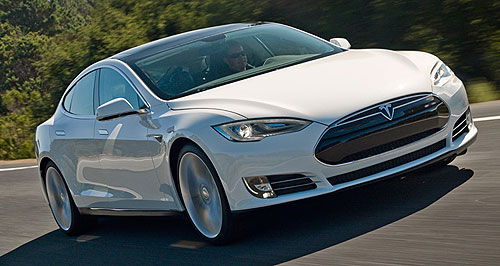Make / Model Search
Future models - TeslaTesla joins race to develop road-going robot carsFuture is now: Tesla could pull the wraps from a self-driving, or autonomous, car inside three years. Self-driving autonomous cars next on Tesla agenda, says founder Elon Musk20 Sep 2013 THE race to develop production cars that drive themselves is heating up, with cutting-edge American EV maker Tesla entering the fray against big fish Mercedes-Benz and Nissan, as well as tech giant Google. In the same week as Tesla shares hit an all-time high of nearly $US180, company founder Elon Musk took to Twitter to canvass his plans for autonomous vehicles, and even advertised engineering jobs reporting directly to him. “Intense effort underway at Tesla to develop a practical autopilot system for Model S,” he posted. “Engineers interested in working on autonomous driving, pls email autopilot@ teslamotors.com. Team will report directly to me.” Furthermore, in a recent interview with the Financial Times, Mr Musk said the company hoped to have a “90 percent” self-driving model by 2016, with a fully autonomous car entering production a little further down the road. After a rough few years of financial losses, Tesla is on a bit of a roll. Order banks for the Model S sedan – which recently achieved the highest ever score of any car in US crash tests – are high in Europe and North America. The company is also working on the forthcoming Model X luxury SUV and rolling out a network of fast-charging devices it calls Superchargers. Not many specifics are known about Tesla’s plan for self-driving cars, although Mr Musk hinted at a few ideas. Despite its comparatively small size, the Californian company has snuck up on mainstream rivals since its inception with the short time in which it has developed its electric cars. The well-received Model S is available with a range of more than 400km, which is well above mainstream – albeit cheaper – EVs such as the Nissan Leaf. “Approach is 360 deg flush mounted tiny cameras + radar (prob not lidar). Lot of software & hardware level image processing,” said Mr Musk. But while Tesla has ideas on paper – or online, as it were – the company has some catching up to do if it wants to catch its rivals. Google has been testing is LIDAR-based system for several years, and one of its autonomous Toyota Prius’ was deemed roadworthy by the Nevada Department of Motor Vehicles in May 2012. Mercedes-Benz went public with its hugely ambitious autonomous-vehicle plans at last week’s Frankfurt motor show, signalling its intention to have self-driving cars readily available within this decade. In a publicity stunt to show its progress, the company ‘drove’ an S-Class with a modified version of its Distronic Plus driver-aid system 100km from Mannheim to Pforzheim, retracing the route driven by Bertha Benz, wife of the inventor of the automobile, Karl Benz, 125 years ago. Nissan, meantime – which alongside Alliance partner Renault has a global joint-venture scheme with Daimler-Benz to share traditional vehicle technology – has been working for several years with researchers from a total of 23 institutions, including Stanford, MIT, Carnegie Mellon, UC Berkley and the University of Tokyo, on self-driving cars. The Japanese car-maker said last week it would have “multiple, commercially viable” vehicles with its ‘Autonomous Drive’ system ready for the market by 2020.  Read more11th of September 2013  Frankfurt show: Mercedes-Benz teases self-driving carAutonomous Mercedes S-Class retraces historic drive in show of tech’s strength28th of August 2013  Nissan reveals driverless car plansAutonomous Drive tech to be rolled out in Nissan models from 2020All future models Alfa Romeo Alfa Romeo Abarth Abarth Alpine Alpine Alpina Alpina Audi Audi Aston Martin Aston Martin BMW BMW Bentley Bentley Chery Chery Brabham Brabham Chrysler Chrysler Chevrolet Chevrolet Cupra Cupra Citroen Citroen DS DS Dodge Dodge Fiat Fiat Ferrari Ferrari Foton Foton Ford Ford Great Wall Great Wall FPV FPV Haval Haval GWM GWM Honda Honda Holden Holden Hummer Hummer HSV HSV Infiniti Infiniti Hyundai Hyundai Jaguar Jaguar Isuzu Isuzu Kia Kia Jeep Jeep Land Rover Land Rover Lamborghini Lamborghini Lexus Lexus LDV LDV Mahindra Mahindra Lotus Lotus Mazda Mazda Maserati Maserati Mercedes-AMG Mercedes-AMG McLaren McLaren MG MG Mercedes-Benz Mercedes-Benz Mitsubishi Mitsubishi Mini Mini Opel Opel Nissan Nissan Peugeot Peugeot Pagani Pagani Proton Proton Porsche Porsche Renault Renault Ram Ram Rover Rover Rolls-Royce Rolls-Royce Skoda Skoda Saab Saab SsangYong SsangYong Smart Smart Suzuki Suzuki Subaru Subaru Toyota Toyota Tesla Tesla Volvo VolvoMotor industry news |
Click to shareTesla modelsAll future models Alfa Romeo Alfa Romeo Abarth Abarth Alpine Alpine Alpina Alpina Audi Audi Aston Martin Aston Martin BMW BMW Bentley Bentley Chery Chery Brabham Brabham Chrysler Chrysler Chevrolet Chevrolet Cupra Cupra Citroen Citroen DS DS Dodge Dodge Fiat Fiat Ferrari Ferrari Foton Foton Ford Ford Great Wall Great Wall FPV FPV Haval Haval GWM GWM Honda Honda Holden Holden Hummer Hummer HSV HSV Infiniti Infiniti Hyundai Hyundai Jaguar Jaguar Isuzu Isuzu Kia Kia Jeep Jeep Land Rover Land Rover Lamborghini Lamborghini Lexus Lexus LDV LDV Mahindra Mahindra Lotus Lotus Mazda Mazda Maserati Maserati Mercedes-AMG Mercedes-AMG McLaren McLaren MG MG Mercedes-Benz Mercedes-Benz Mitsubishi Mitsubishi Mini Mini Opel Opel Nissan Nissan Peugeot Peugeot Pagani Pagani Proton Proton Porsche Porsche Renault Renault Ram Ram Rover Rover Rolls-Royce Rolls-Royce Skoda Skoda Saab Saab SsangYong SsangYong Smart Smart Suzuki Suzuki Subaru Subaru Toyota Toyota Tesla Tesla Volvo VolvoMotor industry news |











Facebook Twitter Instagram